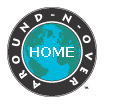|
|
|
 |
|
About the Ocean Phases
Ocean Rowing as a Challenge
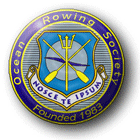
Over 4.000 individuals have climbed Everest. The number of ocean rowers to successfully cross an ocean is
just about 350. According to the compilation of statistics from the Ocean
Rowing Society (as of July, 2008), 347 rowers had completed an ocean row, only 352 boats had ever been launched
to cross any ocean by rowing. Of these, 225 boats completed their voyage, losing 7 rowers at sea. The average age
of an ocean rower was 36. United Kingdom leads the statistics by over 100 boats which have completed any ocean row.
Wikipedia entry
for ocean rowing says:
Ocean rowing is the sport of rowing across oceans. The sport is as much a psychological as it is a physical
challenge. Rowers often have to endure long periods at sea with help often many days if not weeks away. The
challenge is especially acute for solo rowers who are held in especially high esteem within the sport. The
history of ocean rowing is sometimes divided into two eras. The first 12 ocean rows are considered "Historic
Ocean rows" within the sport as they were completed with very limited if any modern technology. The subsequent
rows are described as "Modern Day rows."
The first known rowing expedition to complete an ocean crossing was by George Harbo and Gabriel Samuelson, both
Norwegian immigrants to the United States. Between June 6 and August 1, 1896, these two hardy men left Battery Park
in Manhattan, New York in an open boat and rowed in 55 days across the Atlantic Ocean to the Isles of Scilly in
south western corner of England. The book Daring the Sea is a recount of their experience.
The next successful row to be completed across an ocean did not occur until 1966 when John Ridgeway and Sir Chay
Blyth rowed from Cape Cod to Ireland. It was Sir Chay who approached designer Philip Morrison and his
partner/builder Peter "Spud" Rowsell in 1995 "to design a rowing boat capable of undertaking a competitively
rowed ocean passage. To accommodate two people with their stores and to allow simple construction worldwide."
 Sir Chay Blyth had formed the Challenge
Business to serve as a vehicle to organize regattas, which also handled ocean rowing regattas from the Canary
Islands to the Caribbean Islands. The first regatta took place in 1997 with 24 out of 30 boats that started
crossing the finish line. These identical double-handed boats are now known as the ARR (Atlantic Rowing Race)
design. The regattas are now organized by Woodvale Events and the second generation boats are made using a composite molded hull.
Sir Chay Blyth had formed the Challenge
Business to serve as a vehicle to organize regattas, which also handled ocean rowing regattas from the Canary
Islands to the Caribbean Islands. The first regatta took place in 1997 with 24 out of 30 boats that started
crossing the finish line. These identical double-handed boats are now known as the ARR (Atlantic Rowing Race)
design. The regattas are now organized by Woodvale Events and the second generation boats are made using a composite molded hull.
The design had to be simple to distribute as a kit to all regatta participants, and result in almost identical boats
to enter the race. The goal would be to allow seamanship and pure athletic effort to determine the outcome, and not
the depth of one's pockets in finding better boat designers. This also was a safety consideration to ensure that a
self righting, self bailing, stable ocean going boat would be available to those interested in pursuing this unusual
pastime.
The boat design has a multi-chine hullform in plywood varying in thickness between 1/4" (6 mm) and 3/8" (9 mm),
allowing easier construction. The parts in the kit are all laser cut to interlock in a self-jigging arrangement
which does not require any molds. These are glued together with epoxy resin, reinforced with fiberglass, then
smoothed as necessary. Multiple bulkheads each watertight are accessible via hatches. These provide storage
space for food and gear during the crossings. If any one of the bulkheads springs a leak for some unforeseen
reason, the boat is still designed to remain virtually unsinkable. The concensus is that the ARR boat design
in the end did accomplish the goal of standardizing the ocean rowing vessels for safe crossings.
|
|
The ocean rowing boat: Calderdale
Calderdale was built in 2001 in England. We purchased her after she served in two successful Atlantic crossings.
She arrived at Seattle in a container in October 2004. This will be the boat to use in the upcoming ocean rowing
phases.
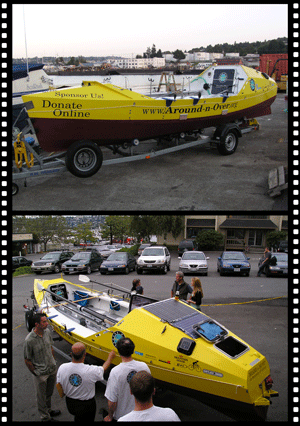
| Boat Designers | Phill Morrison & Peter 'Spud' Rowsell |
| Kit Designer | Jim Moore |
| Length | 7.1 meters, or 23.4 feet |
| Beam | 1.9 meters, or 6.3 feet |
| Weight (empty) | 250 kg, or 550 lbs |
| Ballast | 150 kg, or 330 lbs of water |
| Weight (fully laden) | 750 kg, or 1,650 lbs |
| Structure | Made from Lloyds approved marine Plywood |
The boat has two 12 volt gel batteries which are trickle recharged by solar panels. A desalination unit
which is powered by the same batteries makes drinking water from the sea. The batteries also power the
radar reflector, satellite phone, navigation instruments and other electronic equipment on board. A VHF radio
is used for ship-to-ship communication over short distances.
The progress of the boat is tracked by GPS coordinates that the rower reports in his dispatches. Using
this data, we plot the progress and share it over the internet with everyone. In addition, an ARGOS
beacon on board reports the position at sea without human intervention. This beacon also has an
emergency signal feature, when activated at the same time with the EPIRB, it will be time to scramble
for help. Priority remains to be self-sufficient while at sea and to demonstrate responsible seamanship,
acknowledging the massive resources which would be committed in case of a rescue.
An enclosed cabin in the rear of the boat provides the living quarters. This watertight cabin also
provides buoyancy in case of capsize in a storm. A drogue and a sea anchor are necessary items on board
to better handle the high seas.
There is enough food on board in freeze dried form. It is possible to cook in a stove with gimbals to
keep the food from splashing in the pan. Proper nutrition is crucial for success both in quantity and quality.
The long term isolation in the boat requires a well rounded diet to ensure the rower's physical well being.
Mental well being during the days spent in solitude under continued physical duress is a whole another story...
In case of emergency
A life raft and a grab bag are on board to use in case of an emergency. In such a situation, the rower will activate
an EPIRB (Emergency Position Indicating Radio Beacon) to provide the boat's coordinates to the US Coast Guard.
Rescue coordination centers around the world have long seized on the value of EPIRBS to "take the search out of
search and rescue." The Ocean Rowing Society is on call on behalf of the rower during the ocean phases.
A unique, computer-based, voluntary global ship reporting system called AMVER is used worldwide by search and rescue authorities to arrange for
assistance to persons in distress at sea. With AMVER, rescue coordinators can identify participating ships in
the area of distress and divert the best-suited ship or ships to respond.
AMVER is sponsored by the United States Coast Guard. Its mission is to quickly provide search and rescue
authorities, on demand, accurate information on the positions and characteristics of vessels near a reported
distress. What started out
as "Atlantic Merchant Vessel Emergency Reporting" became "Automated (computerized) Mutual-assistance (its
basic premise) VEssel Rescue (its stated purpose) system, when in 1971 the system was formally expanded
worldwide. Since AMVER acronym was so well known in the industry, the Coast Guard was reluctant to change it.
Today, some 12,000 ships from over 140 nations participate in AMVER. An average of over 2,800 ships are on the
AMVER plot each day. The AMVER Center computer tracks over 100,000 voyages annually. Over 2,000 lives have been
saved by AMVER-participating ships just since 1990. The success of AMVER is directly related to the extraordinary
cooperation of ships, companies, SAR authorities, communication service providers and governments in supporting
this international humanitarian program to protect life and property at sea.
|
|
History of Calderdale
In our search, we found two used ARR boats in UK which peaked our interest. These boats were already used
to cross the Atlantic before and they were being offered with the necessary equipment to make them seaworthy
fairly quickly. The Ocean Rowing Society helped to arrange their inspection by Richard Wood, one of the earlier
ocean rowers who had built one of these boats himself back in in 1997. Based on his advice, we committed to buying
Calderdale - the Yorkshire Challenger.
Calderdale was built by Malcolm Atkison and Ben Martell for their 2001 crossing of the Atlantic Ocean as part of the
Ocean Regatta. She was christened "Kaos" back then. After receiving the boat as a kit described above, they
stitched and epoxied her together. Calderdale is the identical boat which was refurbished for another Atlantic
crossing.
Malcolm and Ben crossed the Atlantic on Kaos traveling east to west in 109 days between October 7, 2001 and January
25, 2002. Their starting point was Tenerife in the Canary Islands, and they concluded their journey in Port St.
Charles in Barbados. 29 boats finished the Ocean Regatta that year.
We bought the boat from The Fund for Epilepsy, the last owner of the boat. The second expedition of our boat was by
Sarah and Sally Kettle, a British mother-daughter team. Sarah was a grandmother when they crossed the Atlantic in
a westward push from La Gomera in Canary Islands to Barbados in the Caribbean. They achieved this goal between
Jan 20-May 5, 2004, taking 106 days to row 3,325 miles. In meeting this challenge, they also set a couple records:
- The first mother and daughter crew ever to row an ocean
- The first all woman British pair to row an ocean
Their project was named the Epic Challenge for Epilepsy. The Kettles used the crossing as a way to support The
Fund for Epilepsy (RCN 1015822) organized by a team of volunteers led by Malcolm and Jane Sykes. The Sykes had a
son named Charles with epilepsy which inspired the setting up of the charity in 1992. Charles died at Christmas
1996, aged 28, shortly after gaining a BSc.
Sally Kettle had attempted the crossing in 2003 with Marcus Thompson, who had epilepsy, following a major road
show that toured England raising funds and awareness for epilepsy. When Marcus developed severe seasickness and
dehydration, they were forced to stop after six days in this first attempt. Sally then recruited her "mum" Sarah
for the 2004 crossing and the rest is history.
Between January 29 and May 2 in 2006, Erden EruÁ crossed the Atlantic
Ocean starting from Las Palmas on a solo attempt to reach Costa Rica. After spending 3 days in the Caribbean Sea
with unfavorable winds and weather reports, Erden returned to Guadeloupe on May 5th. With this solo row, Erden
became the 33rd person in history to row the Atlantic ocean East to West, single-handed.
After having served on three ocean crossings already, Erden used the same boat to row across the Pacific Ocean from Bodega Bay on the California shores to the Papua New Guinea waters.
The launch was on July 10, 2007 and the row ended 312 days later on May 17, 2008. This was the longest time spent at
sea by a solo ocean rower, setting a new Guinness World Record. It took another 20 days of effort on the Bismarck Sea
after the typhoon season to reach the north shores of Papua New Guinea at Finsch Harbor. With that,
Erden became the 4th person to row the Pacific Ocean solo east to west.
A Coral Sea crossing was necessary to continue Erden's human powered circumnavigation. In December 2009, Erden launched
from Port Moresby and 33 days later on January 10, dropped anchor at the mouth of Escape River near the tip of Cape York.
This had been by far a more demanding crossing than the Pacific ever was, navigating the strong tidal currents and crossing
the Great Barrier Reef, all to reach a permissable point for the Australian Customs from which the journey could continue
by sea kayak.
The next opportunity for this rowboat arrived on Erden's Indian Ocean row from Carnarvon in Western Australia to Mahajanga
on Madagascar between July 13 and November 26, 2010. This was the third ocean on this rowboat's career, the first rowboat
to have that honor, making her a historic vessel.
Between 26 March and 20 April 2011, Erden rowed this boat from Mahajanga across the Mozambique Channel to Angoche in
Mozambique. With this additional effort, a mainland to mainland crossing of the complete Indian Ocean was achieved for
the first time in history, another glorious entry in the fantastic history of this boat. |
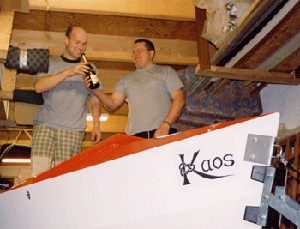 |
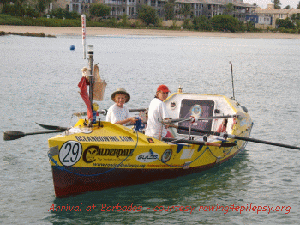 |
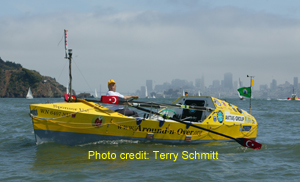 |
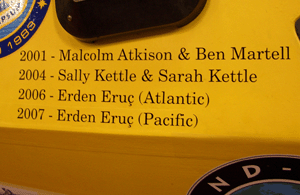 |
|
|
|
